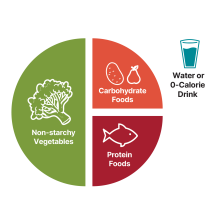
Whether you are a stay-at-home parent, work from home, or retired, many of us find ourselves eating our lunches at home. There are many benefits to eating at home, which includes being able to have complete control of and make informed decisions about what you will eat to help manage your diabetes.
Here’s our advice for planning for your healthy and low-stress at-home lunch.
Set Kitchen Hours
When your kitchen is available to you all the time at home, you have access to more food choices, but you may also be tempted to eat more than you should. Grazing on food throughout the day can disrupt your medication and/or insulin schedule and may lead to missing mealtimes because you are too full.
This is a special concern if you’re managing diabetes because missed meals can cause dips in blood glucose (blood sugar), also called hypoglycemia. It can also lead to overeating later in the day. And, if you’re overly hungry, you might just grab cookies or another unhealthy treat instead of a balanced meal. Try building mealtimes and healthy snack breaks into your calendar or set an alarm so you don’t forget!
One solution is to set kitchen hours—specific set times when the kitchen is “open.” Outside of those windows, the kitchen is “closed.”
In addition to ending the grazing problem, this strategy has a wonderful side benefit: You won’t be doing dishes all day. Have your meal or snack, clean up, and you’re done.
Make a Plan
Often, when you work in an office, weekday lunch decisions happen the day before. Ideally, they’re prepared at home and carried to the office, a move that limits impulse eating and spontaneous lunchtime splurges, such as take out.
You should be doing something similar at home. Meal planning is a great diabetes management strategy. Planning your meals for a full week at a time can help make grocery shopping easier and can help you make healthier, more informed choices. When you’re already hungry, it’s harder to choose the healthy option. Planning your lunch will likely lead to lower-calorie, more vegetable-rich meals.
Remember to Use the Diabetes Plate

The Diabetes Plate can serve as the foundation for planning your meals. That means your nine-inch plate should be half non-starchy vegetables (like broccoli, spinach, or carrots), one-quarter quality carbohydrates (like starchy vegetables, fruit, low-fat dairy, or whole grains), and one-quarter lean protein (like chicken or turkey without the skin).
If you are eating a combination dish like lasagna, think about its parts and where they fit on the Diabetes Plate. The noodles would be the carbohydrate food, the meat and cheese the protein, and the tomato sauce would be the non-starchy vegetable. To increase the vegetables in a lasagna, try replacing half the meat with chopped mushrooms and load it up with more veggies than cheese to get it in line with the Diabetes Plate.
Stock Up on Veggies
In order to fill half your plate with vegetables at lunch, your grocery list should include many produce items (fresh, frozen, or canned with no added salt). This is where shopping and meal planning strategically comes in.
If you’re trying to shop for two weeks’ worth of food, limit items that go bad quickly, like leaf lettuce and herbs, to what you’ll use in the next few days after you shop. Beyond that, plan to use those longer-lasting fresh vegetables like broccoli, cabbage, carrots, and cauliflower.
Batch Cook Your Grains
Make the most of the carbohydrate portion of the plate by choosing intact whole grains (like brown rice or quinoa) or whole wheat pasta. Whole grains are a good source of fiber, which will create a more filling lunch and help manage blood glucose.
Many of the healthiest whole grains take longer to cook, so it can be more efficient to make a big batch over the weekend and store it in the refrigerator to use throughout the week. If you’ve got farro, barley, or quinoa ready to go, it’s easy to mix up a bowl at lunch by adding in the vegetables and lean proteins you have on hand.
Don’t Forget Cans
Salmon, chicken, and tuna in cans and pouches are terrific shelf-stable lean proteins to use at lunch in sandwiches, salads, or bowls. Some are pre-seasoned and have nice flavors. Remember to read the nutrition facts label to see if the sodium, carbohydrate, saturated fat, and protein amounts meet your nutritional needs.
Canned beans are a healthy plant-based staple that play the protein and carbohydrate role on your lunch plate. If you are watching the amount of sodium you consume, purchase no-added-salt, low-sodium, or reduced-sodium canned goods, or rinse canned food to remove some of the sodium.
The Takeaway
If you are eating lunch at home, consider prepping your meals ahead of time and which can help limit your time spent in the kitchen. This strategy may help you avoid grazing throughout the day and makes the healthy choice, the easy choice.
Looking for more lunch ideas? Be sure to check out all the recipes on Diabetes Food Hub and create an account so you can save recipes to try later.














